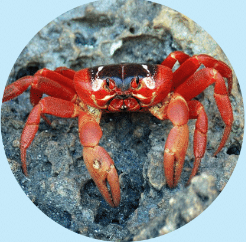Animal Habitats
There is a place for every living creature on this Earth, no matter how strange they may be. Did you know ........
Alaskan wood frogs are amphibians that live in forests where temperatures sometimes drop below -80 degrees. Their bodies freeze solid over the winter months, so their heartbeat and breathing stops. This causes the glucose sugars in their bodies to increase and stops them from dehydrating. In Spring, they thaw out and a ‘normal’ state of life restarts.
It is estimated that on Christmas Island in Australia, there are between 40 to 50 million red crabs. Of course there is also a human population, and special crossings and tunnels have been built to allow them safe passage on land. These crustaceans virtually have no predators and so their population has increased dramatically. They leave their forest homes between October and December to go down to the beaches.
Jellyfish aren’t usually found in lakes, but Lake Palau contains millions of golden jellyfish. It is thought that previous generations got trapped in the lake during a high tide, and ever since, they have been returning to this safe ecosystem to breed. Here, these invertebrates have no natural predators and have adapted themselves to have non-stinging tentacles.

